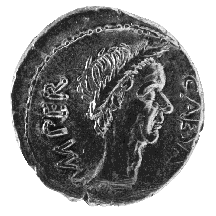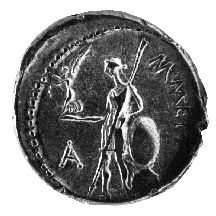



(60) Julius Caesar and Marcus Mettius - AR denarius, 44
B.C., 3.78 g. (inv. 91.106).
Obverse: Laureate head of Julius Caesar r., with long neck; CAESAR IMPER(ATOR):
Caesar, imperator.
Reverse: Venus Victrix walking l., holding small Victoria in l. and spear
in r., with shield at l. side; monogram in l. field; M METTIVS: Marcus Mettius
(mint magistrate).
Provenance: Edward Gans, 1959.
Bibliography: J.P.C. Kent, Roman Coins (London 1978) 17.
Julius Caesar was born in 100 B.C. to a patrician family that claimed descent
from Aeneas, mythical founder of Rome, and his mother, the goddess Venus.
He was one of the greatest speakers, writers, and generals of republican
Rome, and he quickly rose through a succession of offices to become dictator.
Among those who opposed him were the sons of Pompey the Great, whom Caesar
had defeated in 48 B.C. He defeated them at the battle of Munda in 45 B.C.,
after which the Senate voted him the title imperator for life and
the right to wear the laurel wreath, the sign of the victorious general
hailed by his troops. As Caesar's power grew and he accepted honors appropriate
to a king and even a god, Roman aristocrats formed a plot and had him assassinated
on the Ides of March, 44 B.C.
Julius Caesar's coinage before 44 B.C. used the traditional types struck
for his army, making reference to his own achievements and to his claim
that his family was descended from Aeneas and Venus. But in 44 B.C. he also
began to issue coins bearing his own portrait, the first of a Roman to appear
on a coin in his own lifetime, and he thereby established the model for
Roman imperial coinage. The portrait depicts Caesar in the "veristic"
style typical of the late republic, in which experience and wisdom are suggested
by an apparently truthful record of the person's advanced age. He is shown
with a very long, lined neck, a prominent Adam's apple, lined cheeks, and
a high, lined forehead that hints at the baldness he is said to have tried
to conceal with the laurel wreath (Suetonius, Divine Julius, 45).
Here the laurel perhaps represents the gold wreath that he had increasingly
taken to wearing on public occasions. The reverse depicts the family goddess,
Venus, in her military guise as Victrix (Victorious), with her armor and
holding Victoria in her right hand.
C.L.L.



All contents copyright (c) 1996.
Lawrence University
All rights reserved.